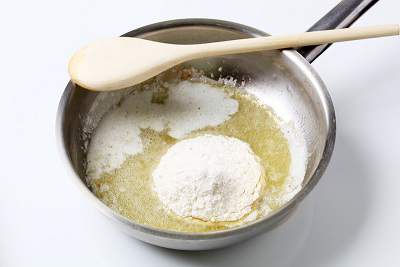Five Mother Sauces

In the early 20th century, Auguste Escoffier refined the list of grand sauces to the contemporary five "mother sauces" by dropping allemande as a daughter sauce of velouté, and adding hollandaise and sauce tomate.
Becoming familiar with these sauces helps you not only in the kitchen, but it helps you to choose from menu items in a restaurant. These sauces and their derivatives are:
Béchamel sauce
Aomard à l'Anglaise ~ anchovy - cayenne - lobster
Cardinal ~ fish stock - truffle - cream - lobster butter
Crème ~ cream - lemon juice
Mornay ~ butter - gruyère cheese - Parmesan cheese
Soubise ~ chopped onion
Oeufs à l'Anglaise ~ diced hard-boiled egg - nutmeg
Espagnole sauce
Bordelaise ~ red wine reduction - poached marrow
Chasseur ~ mushroom - shallot - white wine - tomato concassé
Lyonnaise ~ onions fried in butter
Madeira ~ Madeira wine Périgueux ~ chopped truffles - Madeira wine
Robert ~ white wine - onions - mustard - butter
Mayonnaise sauce (formerly Hollandaise)
Bavaroise ~ reduction of pepper - horseradish - thyme - bay leaves - parsley - vinegar - crayfish - garnished with crayfish tails
Béarnaise ~ tarragon and chervil
Maltaise ~ blood orange
Mousseline ~ whipped cream Noisette ~ brown butter
Paloise ~ mint
Tomato sauce
Chaufroid - aspic jelly
Meat - cooked ground meat
Nantua ~ mirepoix (onion, celery, carrot) fried in crayfish butter - white wine - Cognac - tomatoes - fish velouté - Cayenne
Portugaise ~ fried onions - tomato concassé - meat glaze - garlic - parsley
Provençal ~ sliced mushrooms - sugar - garlic - parsley - oil
Velouté sauce
Allemande ~ veal stock - mushrooms
Curry ~ veal stock - onions - apple - curry - coconut milk
Normande ~ fish stock - mushrooms - oysters - egg yolk - butter - cream
Suprême ~ chicken stock - reduced heavy cream
Vin Blanc ~ fish stock - shallot - butter - fines herbs
Béchamel
One of the simpler sauces, Béchamel is a mixture of blond roux and milk. One cup of milk for a tablespoon of butter and tablespoon of flour is the basis. This is the beginning of a good homemade macaroni and cheese sauce recipe. Simply add your choice of cheese. For a cream sauce, add cream and a squirt of lemon. For ornay, substitute Gruyere cheese for the lemon but keep the cream. A little extra butter, cream, paprika and diced shellfish turns bechamel into a Nantua sauce. Cook some onions and puree or strain after simmering in the béchamel and you will have soubise.
Espagnole
This is close to veloute with the difference being the roux and the stock must be brown. You’ll find this in Chateaubriand with white wine, shallots, lemon and tarragon. Duxelle is a mushroom sauce with tomato, onion, and white wine, but if you use shallots it’s called Chausser. Red wine, shallots, thyme and a bay leaf make up a bordelaise sauce.
Hollandaise
You have to have a double boiler for this or you will scramble the eggs. Melt butter and temper in egg yolk one at a time. Usually four egg yolks to 1/4 pound butter is used. This sauce is especially good with steak or asparagus. To use with steak or asparagus, add shallots, tarragon and champagne vinegar to create Bearnaise.
Tomato Sauce
One of the most popular, you usually buy this in a can and dress it up. It is simply pureed tomatoes (often with other vegetables). Creole (as in shrimp Creole) uses the trinity (bell pepper, onion, celery) with garlic and seasonings. Make it Spanish by adding mushrooms and olives. Milanaise is a favorite with butter and ham alongside mushrooms. Neapolitan combines anchovies with capers, olives and garlic. Bolognese begins with mirepoix (carrot, onion, celery) loaded with ground meat and a bit of red wine.
Veloute
Veloute differs from béchamel by adding stock instead of milk. The stock you use depends upon the sauce you desire. Supreme sauce may get the name from its many uses. Chicken stock is the base of the veloute adding cream and often mushrooms. This is great for use in pot pies. For allemande, veal stock is the base with cream, lemon and tempered egg yolk. Dress up an allemande with tomato paste and butter for a sauce known as aurora. Bercy is created with fish stock, shallots or onion, white wine and butter.

